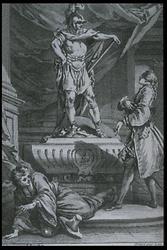Viennese Classic - Early Period#
Christoph Willibald Gluck: Don Juan#
The ballet Don Juan (1761) by Christoph Willibald Gluck (1714 Erasbach/Oberpfalz - 1787 Vienna) counts as the turning-point in the form of descriptive dance for a variety of reasons: it is the first time a ballet was based on a play, the music plays an important role, and the choreography was inspired by classical antiquity (unfortunately none of the original choreography has survived). In contrast to the late Reform Operas, where the music is the servant of the text, music is the leading element here. Dance is supposed to underline the meaning of the music. Gluck also attempts to create unity by using related musical themes. For example, the same kind of whole-tone harmonies accompany the death of the Commander as well as Don Juan's journey to Hell. (E. Stadler)
Picture: The frontespiece of Molière's Dom Juan, which had been performed shortly before Gluck's ballet and can, at least, be considered as the inspiration for the ballet.
Sound Clip#
© MusiContact, Heuauerweg 21, D-69124 Heidelberg, CD-Nr. CHE 0064-2.
